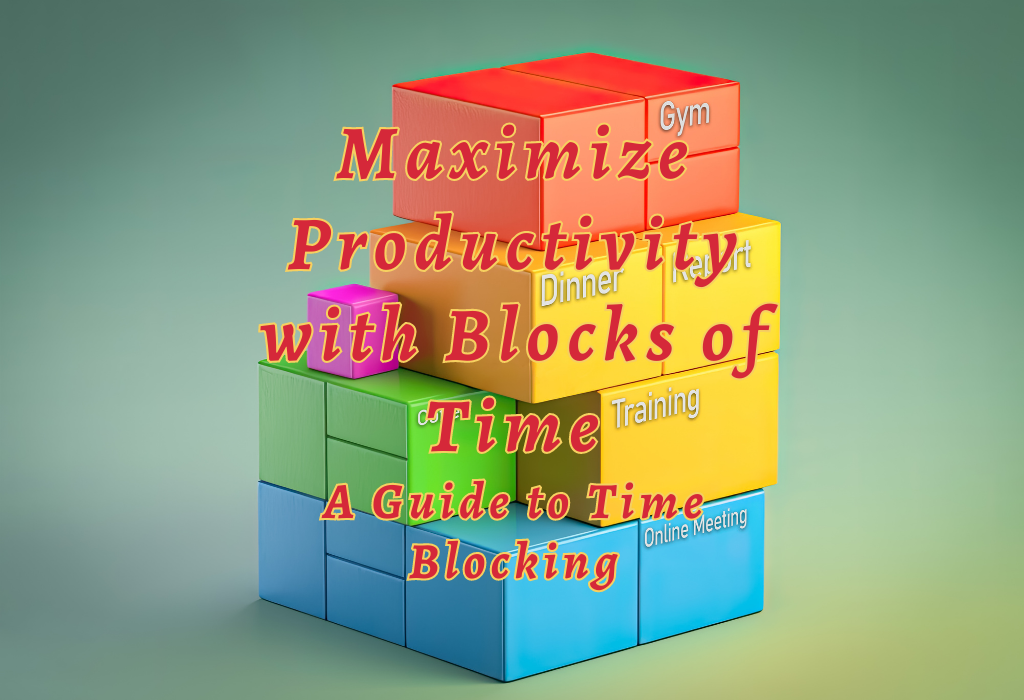Maximize Productivity with Blocks of Time: A Guide to Time Blocking
As someone always on the lookout for greater efficiency and productivity, I’m sure you’ve heard all the terminology associated with maximizing time: Time Blocking, Pomodoro Technique, productive rest, and the list. And while some of these tools have great potential, it’s hardly like a “one size fits all” situation. After all, the best route to greater productivity depends heavily on you and the task at hand.
Far from a new concept, this strategy has been around for millennia, from monks and hermits designing complex time schedules to scheduling lights and darks of the theater. And while you’re likely staging a full-fledged production later, you can still reap the same benefits of using blocks of time when entering each task.
Throughout this guide, we’ll be exploring the usual suspects of time management hacks, but customizing them for anyone, no matter how hectic their to-do list is. Buckle up, folks, because soon enough, you’ll be on your way to becoming the most productive version of yourself!

What Is Time Blocking?
Time blocking involves allocating specific timeframes to specific tasks daily or weekly. It is most commonly used as a productivity enhancer for those with busy workloads.
Advantages of Time Blocking
Taking the time to block out certain parts of your day helps prioritize tasks and ensure your workflow remains uninterrupted. The numerous benefits of utilizing blocks of time are from streamlining communication processes to providing more freedom of movement to working in short, focused bursts.
One of the significant advantages touted by proponents of time blocking is its ability to increase productivity. Studies have shown that because blooming requires planning, it tends to create better structure and consistency in a person’s day-to-day schedule, which often leads to increased efficiency. It helps you budget your resources more appropriately, allowing you to focus your energy on the tasks that require your most excellent attention. It can also improve communication with team members by setting a consistent schedule for when people need to be available for conversation or collaboration.
Drawbacks of Time Blocking
However, only some agree on the efficacy of this system. Opponents argue that focusing too much on structure and rules can inhibit creativity and lead to burnout over time due to its rigidness. They also point out that sometimes unexpected tasks or opportunities can arise throughout the workday, which you need help to accommodate within a prearranged schedule easily.
Ultimately, it’s up to the individual to decide whether blocks of time are an effective way for them to maximize their productivity levels. Those who choose this method find significant benefits in improving their workflow processes and reducing stress levels. With proper implementation, time blocking can give individuals greater control over their workdays and ultimately increase their overall performance.
How to Use Time Blocking: A Step-By-Step Guide
Here is a step-by-step guide on developing an effective time-blocking routine to guide you through the process.
Begin by listing all your tasks for the day and rank them from highest to lowest priority. That will help you better understand where to focus your energy and what tasks are most important to fit into your day. The most important thing to remember when creating time goals is to be specific and realistic; set goals you can achieve within the allotted time frame. This will help create an atmosphere of success and accomplishment, keeping motivation high. Also, writing down these goals to track progress and holding yourself accountable for reaching them is essential.
Once you have established your priorities, assign blocks of time to each task. It could be in 30-minute increments or whatever time frame works best for you and allows you to stay focused without feeling rushed or overwhelmed. Make sure each block of time is realistic, so there is no temptation to keep switching between tasks when one needs to get done faster.
Each task should have a start and end time that are strictly adhered to whenever possible. That will ensure that your day remains structured while permitting you to break away from any task once it’s completed in the allotted amount of time. It is also essential to set some breaks while doing the work. The duration of your breaks will depend on the task’s complexity and the length of your work period. A good rule of thumb is to take a five-minute break for every hour worked so your brain can reset itself during longer deadline-driven projects. Depending on the job, some tasks require fewer 5-minute intervals. Some employees prefer working with more frequent but shorter breaks, while others find taking fewer but longer breaks more beneficial to their productivity and mood.
While maintaining structure is vital with time blocking, flexibility should also be considered in situations such as long phone calls, last-minute requests from a colleague or client, etc. These unexpected events may require that some tasks get pushed back or shortened to accommodate changes throughout the day.
Time Blocking vs. Timeboxing
Time blocking and timeboxing are two oftentimes-confused techniques used to help increase focus, productivity, and efficiency. Time blocking is breaking your day into small chunks to accomplish specific tasks; you pre-allocate a certain amount of time to fulfill specific responsibilities throughout the day.
On the other hand, timeboxing focuses more on creating deadlines or constraints for yourself within which you must finish tasks. While both approaches share some similarities, there are notable differences between these two practical productivity approaches.
Regarding scheduling-related flexibility, often with time blocking, you are provided more flexibility regarding when or where each task or activity occurs. For example, if you are allocated 4 hours for a particular task and by 3 hours, it is unfinished, with time blocking, you can push back the completion to the next available chunk on your schedule.
Another significant difference between these two approaches is that time blocks typically take on a longer duration than those of timeboxes. On the contrary, time boxes usually span shorter increments, such as 10-15 minutes, depending on the allotted task, whether replying to emails or completing a spreadsheet for work.
The underlying debate between these two strategies comes down to preference; no single technique works best for everyone all the time, as everyone has unique needs and varying levels of focus and attention. Some prefer scheduling larger chunks of their day toward one project, while others opt for smaller bits that allow them to tackle multiple tasks simultaneously. Ultimately finding out what works best for an individual mostly depends on their style and commitment to maintaining productivity throughout their workday(s).
Strategies for Managing Blocks of Time
When it comes to managing blocks of time, there are a variety of strategies to ensure productivity and success. While some may prefer to establish rigid daily schedules with detailed instructions for each block of time, others may find that scheduling blocks in smaller or larger increments work better. Additionally, individuals may prefer alternating between desk-based and non-desk-based tasks during each period to stay focused and energized.
To determine which style works best for you, determine your goal—what kind of output do you want to achieve? For example, if you’re setting out to write five articles over a week, ensure that the blocks of time you create are accommodating enough to enable you to work on all five pieces by the week’s end. Simultaneously, ensure that these blocks offer flexibility in case external factors require an adjustment from your initial plan.
Advocates of rigid scheduling will highlight the benefit of mandatory breaks and predetermined periods for resetting throughout the day. Opponents will maintain that, truthfully, creative breakthroughs often happen outside of scheduled times so self-guided flexibility can prove superior here.
No matter what route is taken, limit distractions; consider turning off notifications when tackling creative projects that require immersion to avoid unnecessary interruptions during your block schedule. That also means being mindful about social media scrolling: create specific windows (blocks) dedicated only to this activity to balance surfing and remaining “on task” during any other block durations.
Examples of Utilizing Blocks of Time
Various examples help maximize productivity when building a system around blocks of time. These include allocating equal amounts of time to certain tasks, allowing specific tasks a specified amount, and focusing attention within specific blocks.
This method refers to setting aside identical chunks of time for multiple projects or tasks, using as much time as is needed for each one before moving on to the next task. This approach provides structure and can prevent procrastination, but flexibility should also allow for variations in the amount of time needed for particular tasks.
When using this strategy, the focus is given to just one task at a predetermined amount of time before moving on. That helps ensure that the task receives full attention while also boosting overall productivity by preventing distractions related to multiple projects or tasks. It can help keep people focused on one task until completion, decreasing distractions due to multitasking.
An effective way to utilize blocks of time is to designate certain blocks to specific activities or categories. For example, dedicate one block of the day to create tasks, another to business development tasks, etc. This approach enables maximum production in each area while avoiding “overlap” between activities which could hinder overall productivity.
With these examples in mind, managing blocks of time effectively becomes more accessible and provides people with an improved sense of clarity over their workloads, directly leading to increased productivity.
Common Time-Blocking Mistakes
Here are some common time-blocking mistakes that individuals and teams need to be aware of to make the most out of their time management strategy.
Employees’ focus and motivation can flag and impact their performance over time without adequate breaks every few hours. Therefore, teams must build break times into their daily plans for resting, recharging, and refreshing. Not giving yourself or your team adequate breaks could lead to tiredness, frustration, and loss of focus during the day—all significant contributors to poor output.
With proper planning and estimation skills, managers may judge how long tasks will take to complete and leave sufficient time to attend to important projects. As such, they should always factor in additional buffer time if things don’t go according to plan. Any extra time needed for unexpected complications should already be built into the plan, eliminating potential disruption later in the schedule.
Overcommitting yourself (or your team) is another common time-blocking mistake that is unfortunately observed more often than not. It is also essential to accept limits and adjust accordingly—it’s OK if you don’t get to everything in one go! When scheduling tasks throughout each day, managers need to consider their team’s overall capacity realistically not to burn them out or slow down progress through too much multitasking (which is another mistake associates make). Splitting up your To-Do list over two days or allocating only tasks that require attention today keeps you focused and will likely increase productivity overall.
Planning blocks of rigidly structured time can stifle creativity or disrupt workflow if unexpected events arise—such as urgent emails coming through or having to reschedule a meeting with a client at short notice. As such, it might be better to adopt more flexible blocks that allow for productive work even after changes occur mid-day. Employers must also respect those who choose more unorthodox schedules; allowing employees flexibility may result in greater motivation for longer stretches of focused work when necessary. However, too much flexibility can lead to procrastination, which may affect overall productivity; therefore, employers should decide what works best for their teams based on their tasks and individual preferences.
Frequently Asked Questions
Conclusion
Although it may seem daunting due to some team members’ lack of experience or patience, getting used to regular blocking-off periods could significantly increase productivity over time—provided it’s done correctly!
If managers consider these simple yet sometimes overlooked pitfalls associated with time-blocking strategies, they would undoubtedly set themselves up perfectly towards achieving optimum efficiency levels each day!





